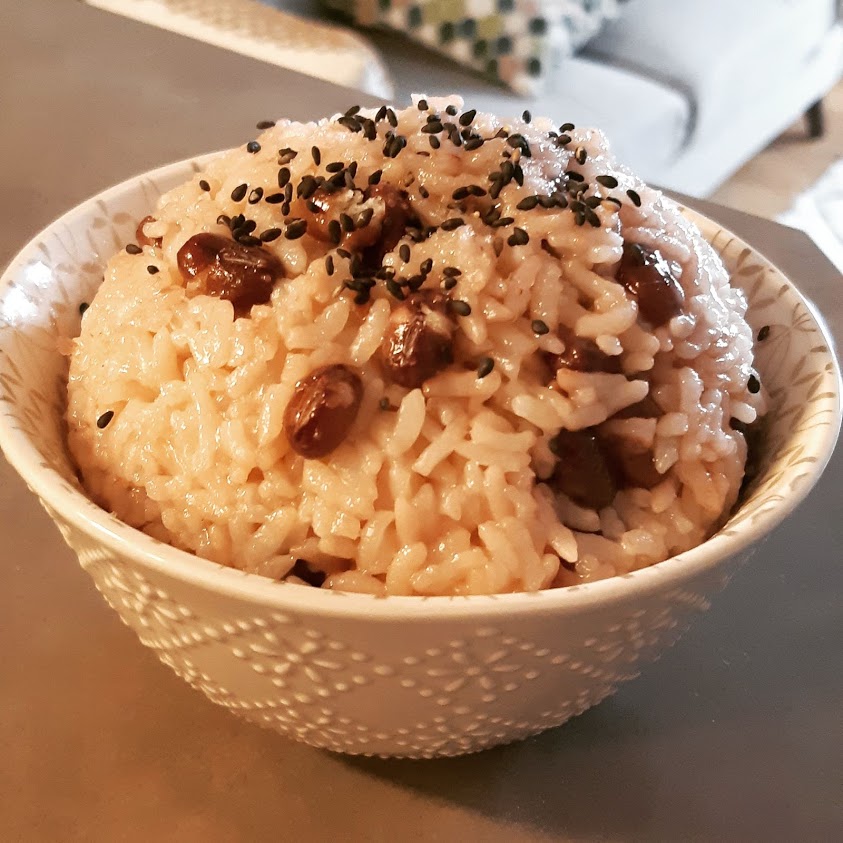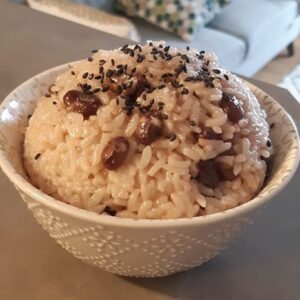Sekihan Rice Recipe

This Sekihan rice recipe is one of my own family traditions! (Rice-py)
I grew up “hapa” in a Japanese family. This doesn’t mean much for many things, but it does mean that every time we get together for any family gathering, you can put your money on sekihan (and we’re Japanese – of course we love gambling!). In fact, when I posted these same pics on Facebook, my mom and aunt both told me that they had made sekihan within the same day…great minds think alike and traditions run deep!
Sekihan, or Osekihan, literally means “red rice” in Japanese. Using asuki (red beans) and mochigome (mochi rice/sweet rice), the dish is most commonly served during festive celebrations in Japanese culture – New Years, etc. In my humble opinion, it is THE perfect snack…year round!
The Perfect Snack
Mochigome, aka sweet rice/short grain/mochi rice/glutinous rice is this awesomely sticky, deliciously chewy white rice. (When it is referred to as glutenous rice, gluten refers to the stickiness, versus actually containing gluten (which it does not)).
Legend has it that red beans signify fertility and good luck (or so our family stories tell us) and combined with the red colour (actually more like purple), is what gives it its festive vibe.
The procedure itself is somewhat lengthy, but actual working time is very limited. First, when using dried beans, you’ll have to soak overnight and boil prior to mixing, but active time here is “as long as it takes to fill a small pot”. Soaking rice is optional (rinsing is not optional!) And otherwise, it is quite simple and takes only a matter of minutes, especially when using a rice cooker or Instant Pot. Heck, even I can do it.
What makes this snack perfect to me is the salt. Honestly, don’t skimp on the salt. Salt helps accent anything delicious (which is why it is used in abundance at restaurants) and sekihan is no exception.
Three simple ingredients finished off with a sprinkle of black sesame. Simply put, you can’t beat it. Try making the greatest thing ever with this simple sekihan rice recipe. You won’t regret it.

Sekihan Rice Recipe
Equipment
- Rice Cooker
Ingredients
- 3 cups Mochi/Sweet Rice
- ½ cup azuki/red beans (pre-soaked)
- 3 cups water
- 1 tsp salt (more, to taste)
- 1 tsp black sesame seeds (garnish)
Instructions
Day Prior
- Soak beans overnight (8-10 hrs)
Day-of
- Boil beans for 20-30 min until "al dente", tender but not mushy
- Rinse mochi rice until water runs clear. Pre-soak, if time allows.
- Add beans, rice and salt into rice cooker and give it a quick stir. Cook to rice cooker normal quantities and timing instructions.
- Sit back and relax for 30 minutes. (make sure not to burn rice to bottom of pot, if doing on stovetop)
- Serve with a pinch of salt and sprinkling of black sesame.
Notes
Sekihan rice can be eaten in a bowl with chopsticks (or spoon if you love it as much as I do); or can be made into nigiri rice balls for an easy portable snack.
Common substitutions:
Regular short grain rice: If you don’t have sweet rice, Japanese rice or sushi rice will work in a pinch, but….if you do have the luxury of mochi rice, do it! You will run into a little less glutinous, but you’re good go. Also consider subbing Thai sticky rice or Korean rice.
Black bean sekihan? Sounds great. Make sure the beans stay a little “al dente” and you should be alright – would that make the rice black?
Long grain: don’t do it! Sekihan is made brilliant by the fact that it is nice and sticky and a little chewy. Long grain is drier and barely sticks together. So, just don’t sub this in. Although, beans would actually make a pretty nice addition to my Mexican rice.
Some general tips and tricks on white rice cooking, check out my how-to here!
Need some rice?
Need a rice cooker?
If you don’t have one, just get a rice cooker. (affiliate links :))
Any family secrets? Any stories? Subscribe and give us a comment! Thanks for stopping in – we’re looking forward to hearing from you.
Enjoy food; enjoy life.
